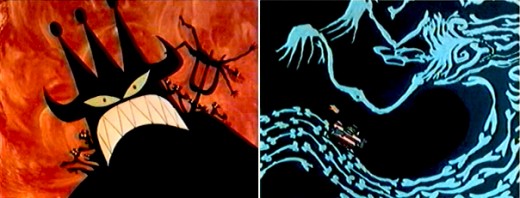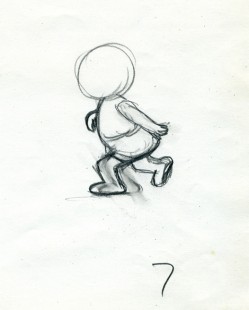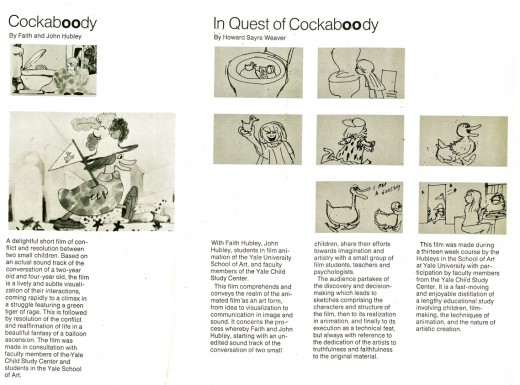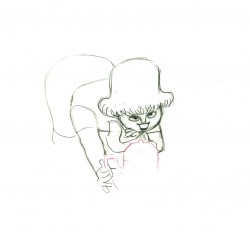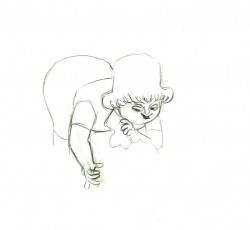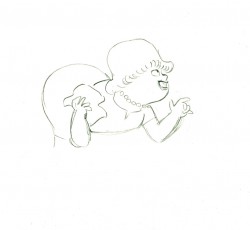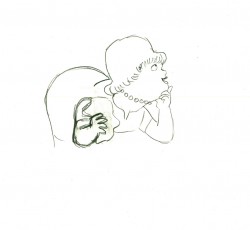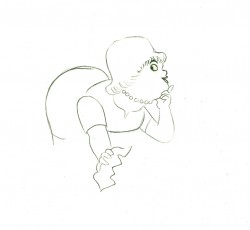Monthly ArchiveJuly 2009
Animation &Disney &Frame Grabs 11 Jul 2009 08:40 am
Whoopee w/names
 - Before there was video tape (which means before there were dvds), there was only 16mm film that you could project in your own home. I had (and still have) a nice collection of decaying movies and used to show these often. One of the regulars to show and watch and laugh at was the great Mickey short, The Whoopee Party. Everyone loved this short, no matter how many times we watched it. It’s a great film!
- Before there was video tape (which means before there were dvds), there was only 16mm film that you could project in your own home. I had (and still have) a nice collection of decaying movies and used to show these often. One of the regulars to show and watch and laugh at was the great Mickey short, The Whoopee Party. Everyone loved this short, no matter how many times we watched it. It’s a great film!
Hans Perk recently posted the drafts for this gem of a film on his amazing resource of a site, A Film LA. (Interesting that they spell the title “Whoopie” in the drafts, but use “Whoopee” on the title card.) Having produced a couple of posts full of frame grabs from this short, I decided to go back and add the animators’ names as sort of a mosaic, similar to what Mark Mayerson has invented in the blogosphere.

1.Hardie Gramatky | 2.Eddie Donnelly | 3.Les Clark

28. SA1 Hardie Gramatky | 28A. SA4 Les Clark | 29. SA1 Hardie Greamatky

32. SA 1. Hardie Gramatky | 33. SA 31 Dave Hand

39. Johnny Cannon | 40. Hardcie Gramatky | 41. Norm Ferguson

41. (cont.) Norm Ferguson | 42. “Frenchy” de Trémaudan

43. Norm Ferguson | 44. “Frenchy” de Trémaudan | 45. Ben Sharpsteen

46. (cont.) 47. 48. Ben Sharpsteen

49. Ben Sharpsteen | 50. Tom Palmer | 51. Norm Ferguson

57. Ben Sharpsteen | 58. “Frenchy” de Trémaudan | 59. Tom Palmer

64. Tom Palmer | 65. “Frenchy” de Trémaudan | 66. Jack King
Daily post 10 Jul 2009 07:56 am
Wild things
There are a couple of pieces worth checking on line, if you haven’t already seen them.

- Ward Jenkins has an extraordinary 2 part interview with Jon Graboff the son of illustrator/designer Abe Graboff.
Ward, who has obviously taken a lot of inspiration from Abe Graboff and his many children’s books, asks insightful questions and posts lots of material to give you a good overall view of the masterful work. Everything from samples of the many books to the opening titles to The Danny Kaye Show. Ward makes a strong case for this work and helps to keep it alive.
 - Ward Jenkins, on his blog, also introduced me to a wonderful site, Terrible Yellow Eyes. Cory Godbey has created a home for a lot of art inspired by the primal children’s book, by Maurice Sendak, Where the Wild Things Are. Many works are posted by many and varied artists (including Ward Jenkins) who have been invited to post something. Take a look at some of this artwork; many are beautiful. The range of styles is wide, but there being one source of inspiration it’s nice to see what people do with it. Some are clever, some are brilliant. It brought me back to the original which didn’t inspire me as much as Mickey in the Night Kitchen did. Maybe it’s generational.
- Ward Jenkins, on his blog, also introduced me to a wonderful site, Terrible Yellow Eyes. Cory Godbey has created a home for a lot of art inspired by the primal children’s book, by Maurice Sendak, Where the Wild Things Are. Many works are posted by many and varied artists (including Ward Jenkins) who have been invited to post something. Take a look at some of this artwork; many are beautiful. The range of styles is wide, but there being one source of inspiration it’s nice to see what people do with it. Some are clever, some are brilliant. It brought me back to the original which didn’t inspire me as much as Mickey in the Night Kitchen did. Maybe it’s generational.
The inimitable Hans Bacher on his brilliant site, posts about Errol LeCain‘s work with Richard Williams on the film The Sailor and the Devil. This film is just impossible to see these days, so it’s wonderful to view frame grabs, courtesy of Hans, from the short. Unfortunately, of course, the still pictures don’t capture the beautiful rhythms of the film. As a Le Cain fanatic, however, it’s wonderful to have this much. Many thanks to Hans for all the pleasure, inspiration and instruction he gives me with his site.
Of course, if you don’t go to this site regularly, you’re missing real treasures. Just this week, aside from The Sailor and the Devil, Hans focused on the real locations of Pinocchio and Williams daredevil animated feat, the Jovan commercial. So much gold to view.

.
Stephen Worth on the Asifa Hollywood Animation Archive has posted some excellent and early artwork by Ray Patterson from the Mintz Studio. There’s a wealth of material here and some fine drawing.
I have a real love of the early material from animation’s beginning. I don’t know what it is, but I can’t get enough. Simply charming.
- Finally, there’s an article in today’s New York Times about a Wall Street analyst who apologizes for predicting that UP would not be a financial success.
- “The recent success of Pixar’s ‘Up’ (well ahead of our forecasts) has renewed investor confidence in Disney’s creative capabilities,†he added. “Up†has so far sold $265.9 million in tickets in North America and $35.4 million overseas, where it has only begun to arrive in theaters.
However, he still recommended selling the company’s stock, saying he believed the next 12 to 18 months would be “substantially more difficult for Disney than investors are currently anticipating.â€
Perhaps he’ll be wrong about that as well.
Animation &Hubley &repeated posts &walk cycle 09 Jul 2009 08:12 am
Recap – Georgia walk
 – Having posted a piece about John and Faith Hubley‘s Cockaboody yesterday, I thought I’d take the opportunity of showing off another older piece from Aug ’07. This walk cycle was animated by Tissa David. The drawings are partic-ularly rough – her first shot at the walk designed for her eyes only.
– Having posted a piece about John and Faith Hubley‘s Cockaboody yesterday, I thought I’d take the opportunity of showing off another older piece from Aug ’07. This walk cycle was animated by Tissa David. The drawings are partic-ularly rough – her first shot at the walk designed for her eyes only.
Tissa is careful not to use too much paper. Hence she reuses old paper for her very rough preliminaries as she figures out her animation.
It’s frequent, when visiting her work space, to see lots of pages featuring characters on both sides of the paper upside down as well as sideways. She doesn’t often let these rough roughs out of her hands before she throws them out. I guess I was there at the right time and talked her into giving me these drawings.
She animates the walk, here, on top pegs bacause that’s all she has left of space. Tissa nomally works on bottom pegs. Actually, since this is going to be a sliding cel, it would have been done top pegs anyway.
Georgia, the younger girl, leaves the bathroom and moves to the floor to play with a doll (whose head she accidentally pulls off).
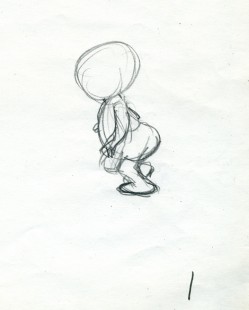 1
1  2
2
(click any image to enlarge.)
 3
3  4
4
The walk is heavy and a bit flatfooted. She doesn’t come down on her toes but plants the entire foot.
 5
5 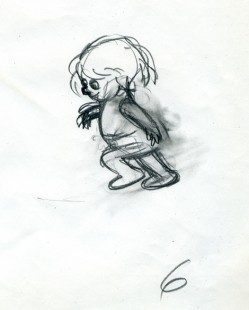 6
6
Her arms are high because, a baby, she’s still a bit off balance.
Click the very lower left to put the QT into motion.
Click the lower right to watch it a frame at a time.
Animation Artifacts &Hubley 08 Jul 2009 07:30 am
In Quest of Cockaboody
- John & Faith Hubley‘s short Cockaboody was a gem of a film culled from the vocal play of their two daughters, Georgia and Emily. I’d posted the storyboard for this back in July 2007 in three parts:
Part 1
Part 2
Part 3
The film was developed within the Hubleys’ animation class at Yale, and the school shot a short documentary on the making of the animated film as it progressed. This documentary was an absorbing look, not only at the film in progress, but at the process of animation as well as the methods of Hubleys as their work grew. In Quest of Cockaboody premiered Dec. 13, 1973, and here’s the invitation that was sent out for the film shown in conjunction with Cockaboody, itself.

Front (Click any image to enlarge.)
I’ve only seen the documentary once. There must be a copy floating around, but I haven’t seen it in 35 years. Needless to say, it’d be interesting to see it again.
Cockaboody was animated, entirely, by Tissa David. Here are some of poses she used in prepping the film for herself.
 B7
B7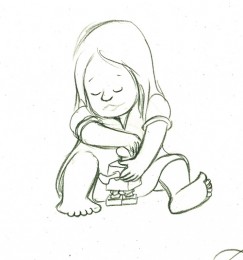 B -
B -
Commentary &Daily post 07 Jul 2009 07:23 am
Alice apoplexy
 - The internet has been overrun with images from Tim Burton’s Alice in Wonderland, now in production. Lots of Victorian inspired, detailed photos of stars dressed like characters from the film. I’ve pulled a few of them and am posting them here.
- The internet has been overrun with images from Tim Burton’s Alice in Wonderland, now in production. Lots of Victorian inspired, detailed photos of stars dressed like characters from the film. I’ve pulled a few of them and am posting them here.
Alice has been a problem project which so many studios, artists and filmmakers have attempted to tackle. None have been very successful. The 1933 Norman McLeod version was one of the first and one of the better versions. Edward Everett Horton, Sterling Holloway and Richard Arlen give Charlotte Henry enormous support in this interesting albeit very stagey version.
 Disney’s animated feature is probably one of the best known of the films. It’s good in its own rite, but hardly captures the imagination of the Lewis Carroll book or the Tenniel illustrations.
Disney’s animated feature is probably one of the best known of the films. It’s good in its own rite, but hardly captures the imagination of the Lewis Carroll book or the Tenniel illustrations.
Lou Bunin‘s version is very studied and lacking in much of the drama and whimsy of the story. As a matter of fact, that’s the problem with most of the versions. The story is somewhat like Candide in that it is picaresque in its adventures and becomes hard to dramatize. Burton’s an accomplished filmmaker, but his recent films have begun to look alike. Sweeney Todd doesn’t have the depth that it might have. A lot went into trying to captures Sondheim’s brilliant score, but that came at the expense of the story, itself, which became too much of a surface event.
Regardless, the pictures have had their effect in that it’s made me curious to see what he’ll do with the book.
Here’s a short commentary by Wolcott Gibbs I found in the July 16, 1938 issue of The New Yorker magazine:
 We are one Walt Disney’s warmest admirers, but we can’t approve of his notion of making an animated cartoon out of “Alice in Wonderland,” Mr. Disney says that if he ever does make the picture, he proposes to follow the Tenniel illustrations, at least in spirit.
We are one Walt Disney’s warmest admirers, but we can’t approve of his notion of making an animated cartoon out of “Alice in Wonderland,” Mr. Disney says that if he ever does make the picture, he proposes to follow the Tenniel illustrations, at least in spirit.
We don’t think this is going to work. Tenniel drew with a fine line, in enormous detail; the movies call for simple, conventionalized figures. The result would be that; Alice would look like Snow White (and probably talk like an elocution school) and a lot of nice, middle-aged people would get apoplexy.
Even harder than reconciling the styles of drawing, we think, would be the problem of adjusting Lewis Carroll’s humor to an audience of a hundred million people, many of whom consider Joe E. Brown the nation’s foremost comic. We don’t like to think of the things that would have to be done to make Alice a box-office success. We don’t want to see the Frog-Footman swallow a cake of soap and hiccough bubbles, or to hear “Jabberwocky” set to swing.
As a matter of fact, we never want to see Alice move or talk at all, and we don’t really believe that Mr. Disney, a modest man, wants to make her, either.
Animation &Animation Artifacts &Tissa David 06 Jul 2009 07:29 am
A Simple Move
- Here’s what looks like a simple move done by Tissa David when she animated this Viva, paper towel commercial.
The character’s move in this scene is a complicated one done simply. She has been bent over, cleaning with her paper towel, and she moves up. You can follow the overlapping action as her eyes pull her up, head turn, and body follows.
The stripes will come and go. Tissa depends on someone else to concentrate on this material when she’s working on a commercial.
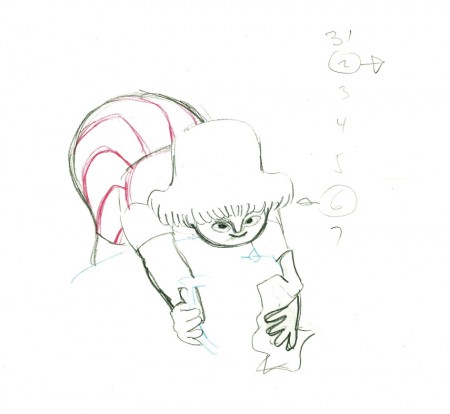 e37
e37(Click any image to enlarge.)
 e44
e44
Her eyes point in the direction she wants to go,
and the rest of the scene moves her up and into profile.
This key move is hidden under the exchange of the
paper towel from one hand to the other.
 e51
e51
She stops to think (accenting her monologue.)
 e58
e58
And she slyly looks back to camera to respond with her thought.
 e59
e59
She continues, all through this move, talking.
She’s pitching the product.
Here’s a QT of the piece:
Cleaning for VivaClick left side of the black bar to play.
Right side to watch single frame.
Articles on Animation &Commentary 05 Jul 2009 08:37 am
Violence & Joe Barbera
Having posted some photos yesterday for July 4th, let me turn to something animated.
- After seeing Ice Age 3 (or half of it, I had to leave), I began to think about children’s films. The pendulum seems to have swung again. There was a time when Variety and The Hollywood Reporter were filled with articles pro and con cartoon violence. (Violence can be ripping the hair off an animal’s chest or attacking dinosaurs.) Once the networks stopped airing their Saturday morning blocs of programming, no one seems to have taken much notice.
This is an article by Joe Barbera about why he should be allowed to smash Tom in the teeth with a golf ball. (It’s funny!)
I’m posting this as a reminder that there ARE consequences to what we show and tell our children.

Pick a cartoon gag. Any gag. Remember the one when Tom hit a golf ball off Jerry’s ear, only to have it ricochet off a tree and come back dead solid perfect off Tom’s teeth? Or how about the one in which the bad guy drops an anvil off the head of Huckleberry Hound, who shakes it off and wobbles away. Sound familiar? Remember when you were a kid, how you laughed at those? Take my word, you did. But those gags and others like them are only memories now because you won’t see them on cartoons produced today.
 Today’s cartoon shows, believe it or not, are not allowed to contain gags of this type. Why, you can’t even throw a cream pie at a character. Explain that to Soupy Sales, who made it into a comic art form that gave us all a big laugh. These visual gags are considered too violent; too extreme; too negative an influence on today’s cartoon watcher.
Today’s cartoon shows, believe it or not, are not allowed to contain gags of this type. Why, you can’t even throw a cream pie at a character. Explain that to Soupy Sales, who made it into a comic art form that gave us all a big laugh. These visual gags are considered too violent; too extreme; too negative an influence on today’s cartoon watcher.
For that you can blame, or thank, depending on your point of view, broadcasters, who have been effectively lobbied by small but exceptionally effective pressure groups. I’m sure they have all the best intentions in the world, but what they may not realize is that they are destroying the cartoon as we know it and diminishing the creativity that has made animation a successful, entertaining medium. Now cartoons are produced using what I call “compromise humor.”
It started a decade, ago when a concerned group of parents and teachers complained that cartoons were to blame for society’s ills. Television personnel took heed of the outcry of a vocal minority and put their collective foot down as to what is and what is not acceptable in today’s cartoon.
Now, don’t get me wrong. I understand everyone’s concern. But I don’t think they fully realize the consequences of these limitations. By placing the same restraints on the animation producers, the material is being flattened out. In other words, the creativity in what we can do is limited. Because the same “rules” apply to us all, there comes a feeling of sameness in all new cartoons produced, which television critics have noted this season. The little touches of style and timing that would separate each cartoon series and production house are not as distinctive as they once were, and that is a shame.
If the same set of rules were around 30 years ago, Hanna-Barbera would have never produced Huckleberry Hound, Yogi Bear, Quick Draw McGraw and the Flintstones as we know them today. What made those shows and others successful was exaggeration — the hallmark of animation. Cartoons are an exaggeration of real life. Cartoons are fantasy and fun. Cartoons are not real life. Cartoons are not the solution to the world’s problems, and it is my belief they should not be forced to pretend they are.
The cartoon is a visual medium, expressing universal humor that reaches all children of every nationality without the need for words. I still don’t know if adults realize that children have different standards as to what is funny and what isn’t.
Again, don’t get me wrong. There are still boundaries of good taste we should adhere to. Hanna-Barbera will never do a cartoon promoting drugs, for example. In fact, we produced a primetime special ABC aired this season called “The Flint-stone Kids, Just Say No.” The White House commended the special, which is now available on home video, with a portion of the proceeds to benefit the Just Say No campaign.
Obviously cartoons should not take the place of the personal guidance of parents and teachers. Situations that are real and factual are the job of schools, mom and dad, grandma and grandpa.
 Let’s face it. Kids are not watching cartoons for educational input: They are watching to be entertained. You can’t have a cat chasing a mouse stop to teach it about American history. It doesn’t work. We tried it. We’ve worked with consultants and pressure groups but the kids were bored and turned us off.
Let’s face it. Kids are not watching cartoons for educational input: They are watching to be entertained. You can’t have a cat chasing a mouse stop to teach it about American history. It doesn’t work. We tried it. We’ve worked with consultants and pressure groups but the kids were bored and turned us off.
If children don’t find something that entertains them on television, they pop a cassette of classic cartoons into the VCR and watch them instead.
While my partner Bill Hanna and I are on the road promoting the homevideo tapes we sell, we hear from hundreds of parents who make a special point of telling us how much they love our shows, and trust them. Many parents have confided to me that they are concerned about what their children watch, but think it’s completely safe for their children to watch a Han-na-Barbera show. They confess that they like to watch our shows with their children, but don’t find the cartoons of today very funny. They want to know when we are going to bring our good old ones back.
I think the kids who watch cartoons agree with me. ABC brought back Bugs Bunny and Tweety cartoons to Saturday morning this season. These are not new cartoons. Most of them were made more than 40 years ago, with good old exaggerated gags. The fact that the show is doing well in the ratings suggests that children like these cartoons. But if those cartoons were being produced under today’s strict standards, the same type of humor wouldn’t be there, and I guarantee the ratings wouldn’t be either.
Cartoons are supposed to start where reality ends. If you want to put three heads on a character, you do it. You shouldn’t have to stop and think about who would like it and who would find it distasteful. Something like that works better visually than it will ever sound in words.
We did a successful cartoon series in 1964 called “Jonny Quest.” It was the forerunner to Indiana Jones. It was a family action-adventure series with human characters, not animal characters with human traits. It featured Jonny Quest, an 11-year-old boy, who helped his father battle Dr. Zin and others with futuristic gadgets, lasers and submarines. Now we don’t expect 11-year-old boys to find their neighborhood submarine and leave home, but our watchdogs act as if those things were really going to happen. With the restrictions that inhibit imagination, the Indiana Jones-type entertainment would not be nearly as successful. In fact, if today’s standards were around back in the Golden Days of Television, I seriously doubt if Laurel and Hardy and Buster Keaton would have made it.
Children are entitled to their own entertainment. Today’s children exhibit signs of stress and pressures at younger ages. I would rather they found a release valve by watching cartoons purely for entertainment than be exposed to the sex and violence of primetime programs and the news.
So what is the answer? Let Hanna-Barbera and the other animation producers govern themselves. Let Hanna-Barbera take the experience of seven Oscars and eight Emmys and do what we do best. We know what makes a cartoon funny. We know the boundaries of good taste. Please don’t let “compromise humor” become the standard that governs creativity.
To end this, let me give you the lyrics of a great song by Stephen Sondheim from Into the Woods:
Nothing’s all black, but then nothing’s all white
How do you say it will all be all right
When you know that it might not be true?
What do you do?
Careful the things you say
Children will listen
Careful the things you do
Children will see and learn
Children may not obey, but children will listen
Children will look to you for which way to turn
Co learn what to be
Careful before you say “Listen to me”
Children will listen
Careful the wish you make
Wishes are children
Careful the path they take
Wishes come true, not free
Careful the spell you cast
Not just on children
Sometimes the spell may last
Past what you can see
And turn against you
Careful the tale you tell
That is the spell
Children will listen
How can you say to a child who’s in flight
“Don’t slip away and I won’t hold so tight”
What can you say that no matter how slight won’t be misunderstood
What do you leave to your child when you’re dead?
Only whatever you put in it’s head
Things that your mother and father had said
Which were left to them too
Careful what you say
Children will listen
Careful you do it too
Children will see
And learn, oh guide them that step away
Children will glisten
Tample with what is true
And children will turn
If just to be free
Careful before you say
“Listen to me”
Daily post 04 Jul 2009 08:04 am
4th of July Spectacular
To celebrate July 4th I’d like to post a couple of pictures by friend, Steve Fisher. These two shots of the sky were taken this past week. Every day we’ve had torrents of rain and thuderstorms pelting us with a lot of water. After one evening’s sky show, the setting sun mixed with the clouds to give us a very odd sunset. Steve captured it in these photos. (The cameramen of the NYYankee game were equally inspired and kept showing the sky.) Nature’s enough for me for July 4th.

(Click any image to enlarge.)
____________________
A good friend has some real film (and I do mean film) equipment he’d like to pass on to a good home. I told him that I’d post his offer:
- 7/1/09
ANIMATOR SEEKS LOVING HOME FOR OLD MACHINES
Because I now exclusively use digital acquisition I offer this equipment to the right party, free, with the condition that you take it all and have a plan for using it that doesn’t include selling or scrapping it, at least not right away.
These machines served me well as an independent animator and commercial producer from the early 1970s up to the new millennium when I began using a still camera on a copystand.
INVENTORY
1. One Bell & Howell 2709 35mm cine camera. Both Acme and Oxberry cameras were based on the shuttle on the 2709 because of its superior stationary registration pin system. The original model can be found at film museums,
 The camera was modified to down-shoot by removing the turret, beefing up the precision rackover plate including a stationary Nikon lens mount (I used a 55mm micro-Nikkor, not included), and motorizing the take-up and supply pulleys. The camera has a reticle on the access door which allows one to view through the lens or project an accurate guide onto a flat field with the included prism/light-source unit. The variable shutter is controlled by a large gauge to make fades. An A/C stop-motion motor with frame counter runs at 3 exposures (1/4, ½, one second) forward and reverse. Includes two standard 35mm
The camera was modified to down-shoot by removing the turret, beefing up the precision rackover plate including a stationary Nikon lens mount (I used a 55mm micro-Nikkor, not included), and motorizing the take-up and supply pulleys. The camera has a reticle on the access door which allows one to view through the lens or project an accurate guide onto a flat field with the included prism/light-source unit. The variable shutter is controlled by a large gauge to make fades. An A/C stop-motion motor with frame counter runs at 3 exposures (1/4, ½, one second) forward and reverse. Includes two standard 35mm
magazines and one dual chamber bi-pack
magazine (made out of wood; it will need some modification for film take-up).
All controls for shutter and focus are totally manual.
This camera is NOT for purists who get all sentimental over the authentic hand-cranked camera that became the “standard†for Hollywood features in the silent era. True, there is a hole for the crank handle, but the chopped off turret radically alters the appearance of the all-aluminum body. The modification for animation may have been done during WWII for the Army Signal Corps which produced many films in Brooklyn using equipment that later ended up in animation studios around the city.
2. A second Bell & Howell 2709 35mm cine camera. Modified generally the same as the first camera except it has a 16mm shuttle and the take-up tension is supplied by the camera with the original springbelt loop, not independent motors. This is a newer camera built I would guess after WWII. Includes one magazine.
Both cameras are interchangeable. They fit on the rackover plate on the same pilot pins; use the same light for their respective field reticles; use the same stop-motion motor.
The cameras and animation stand (which I donated long ago) were used by the Bray Studio located in the Film Center Building on 9th Ave. Historians know that the original cartoon studio, founded by John Randolph Bray in 1910, is where the Fleischer brothers and so many other pioneers started out. By 1972 they were using an Oxberry to make training films for the military. I bought the lot for $2500 and installed it in a loft in Chinatown. During the next twenty years the stand was used by a wide swath of animators — David Ehrlich, Bill Plympton, Anthony McCall, Lee Savage, to name a few — and was pictured in Kit Laybourne’s classic “The Animation Book.†(Three Rivers Press, 1998)
3. Moviola 35mm picture, 1-35mm magnetic sound. This is a classic compact green upright editing machine in very good running condition with new belts.
4. Moviola 4 gang synchronizer (2-35mm, 2-16mm), one sound head with squawk box.
5. Seimens 16mm interlock field projector with variable speed motor and 3 sound options: optical, magnetic stripe and magnetic full coat interlocked. 1000’ reel.
6. Revere 16mm silent projector with variable speed motor. Very good condition.
7. Maier-Hancock 16-35mm hot splicer. Very good condition.
The ideal destination for this trove (“hoard�) would be a mad scientist-tinker-animation nut who is unaffected by the current relentless stampede toward the latest digital gadget or paradigm shift, or a collective of makers who see it as colossal kinetic sculpture, or working parts of a totally devolved studio producing films the old fashioned way for projection at the local cinema.
If you’re interested please contact me: gg@geogrif.com and use “2709†as the subject
This picture by Steve Fisher is too good not to post again.
Have a happy 4th of July
Commentary 03 Jul 2009 09:04 am
Animated sounds
- In the past there were a limited number of animated studios. Disney, Warners, MGM, Fleischer, Paramount, Lantz, Terrytoons, Columbia/UPA. The interesting thing about every one of those studios is that just by listening to a snippet of any soundtrack from any of the films, you could tell which studio had produced the short.
- The rich, symphonic scores and orchestrations of the Disney films by Frank Churchill, Leigh Harline and Oliver Wallace among others.
- The WB films had the strong Carl Stalling style.
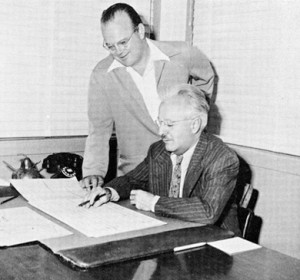 - There was the richer, yet, equally strong Scott Bradley style for MGM. Who used more original and modern music for his scores.
- There was the richer, yet, equally strong Scott Bradley style for MGM. Who used more original and modern music for his scores.
- That oddly orchestrated sound for Fleischer/Paramount kept changing in the same direction whether under the direction of Sammy Timberg or Win Sharples.
- Terrytoons had to have had the oddest sound under Phil Scheib. Even the Terry sound effx felt as though they were recorded under water and had a peculiarly original sound. It was an acquired taste, but I loved it.
- Clarence Wheeler helped Walter Lantz bring a large number of jazz scores______Tex Avery & Scott Bradley (seated)
to his forties films and found an original
formula for the shorts he scrored in the fifties. Again these Universal cartoons sounded different from the other studios’ tracks.
- On the completely other end of the spectrum were UPA’s chamber groups done in that style for the cost factor, but the composers were all artists and the scores were well ahead of their time, musically. David Raksin, George Bruns, and Gail Kubik among others writing these scores. Nothing else sounded like it.
 There was no doubt the Terrytoon’s scores by Phil Scheib (seen left) weren’t for a Disney project, and the sometimes-too-rich Disney scores weren’t for the MGM films (even the Harman-Ising films emulating Disney sounded different.) The MGM scores were different stylistically from the Stalling WB scores – even though the visuals were done by many of the same people travelling across town.
There was no doubt the Terrytoon’s scores by Phil Scheib (seen left) weren’t for a Disney project, and the sometimes-too-rich Disney scores weren’t for the MGM films (even the Harman-Ising films emulating Disney sounded different.) The MGM scores were different stylistically from the Stalling WB scores – even though the visuals were done by many of the same people travelling across town.
In short, I think these scores almost served as a trademark for the individual studios. This is something I don’t see (hear) in today’s films. Most of the composers are independent artists tavelling from studio to studio. John Powell or Randy Newman, or Hans Zimmer bring their individual sounds to whichever studio’s films they score. (Alan Menken and Michael Giacchino seem to be the nearest thing to house composers, the former having done a number of Disney scores and the latter only music for Pixar films. Neither has moved to any other studios, as yet.)
Since many of the artists seem also to be traveling back and forth between studios, the end result is a sort of homogenization of the films. Many of the CG films look like others of the CG films. The differences are certainly not in the soundtracks, although the Dreamworks films have more of a preponderance for screaming rather than talking. This trait is also recently showing up in the Pixar films.
Hans Zimmer has written:
Disney: The Lion King
Dreamworks: Madagascar 1 & 2, Kung Fu Panda, Shark Tale, Spirit, Prince of Egypt,
Steven Schwartz wrote lyrics and/or songs for:
Disney: Pocahontas, Hunchback of Notre Dame, Enchanted
Dreamworks: The Prince of Egypt
Randy Newman:
Disney/Pixar: Toy Story 1,2&3, The Frog Princess, Monsters Inc, Cars, A Bugs Life
Henry Selick: James and the Giant Peach
John Powell has scored:
Disney: Bolt
Dreamworks: Shrek, Kung Fu Panda, The Road to Eldorado
Blue Sky: Robots, Horton Hears a Who, Ice Age 1,2,3
Aardman: Chicken Run
Universal: Happy Feet
me: Goodnight Moon (I was first)
Animation &Animation Artifacts &Chuck Jones &UPA 02 Jul 2009 08:01 am
Gay Purr-ee
 - I remember in 1962 going to the movies to see Gay Purr-ee, the very first showing – a late morning matinee. It was a bus ride away, but I was a fan big fan of UPA at the time. A 15 year old child who knew a bit about the impressionists and had read a lot about the early incarnation of this animation studio. The only shorts I’d seen were on the original Gerald McBoing Boing show, back in the fifties (when I was much younger.)
- I remember in 1962 going to the movies to see Gay Purr-ee, the very first showing – a late morning matinee. It was a bus ride away, but I was a fan big fan of UPA at the time. A 15 year old child who knew a bit about the impressionists and had read a lot about the early incarnation of this animation studio. The only shorts I’d seen were on the original Gerald McBoing Boing show, back in the fifties (when I was much younger.)
1001 Arabian Nights with Mr. Magoo had impressed me in some of its parts, but the notion of animating in impressionist art was more exciting to me.
I remember being impressed with the voice cast and soundtrack (which I quickly bought), some of the imagery and some bits of the animation. I loved the thick/thin outlines of the characters. I went back the next day to see the film again at a closer theater. This time I went late afternoon, which was a mistake. The kiddee matinee had brought a glob of ice cream melting down the center of the theater’s screen. It was hard to enjoy the beautiful painting with this dark, moving scar gracing the middle of the screen.
Despite seeing the film another half dozen times, since then, I didn’t really know much about the film’s production other than the credits I was able to view on screen. The Abe Levitow site offers a number of background paintings by the original designer, Victor Haboush, as well as Corny Cole and Bob Inman.

Here are two by bg’s Victor Haboush that are featured on the Levitow site.
I just earned from Tom Sito‘s blog that Mr. Haboush died on May 24th at 85.
He was a gifted designer and artist.
.

.The paragraph written on that site tells about the layoffs at Disney after Sleeping Beauty and how this brought an influx of talent to UPA. Many had worked on the Dick Tracy and Mr. Magoo tv cartoons that were produced but the feature better utilized their talents.
This isn’t much different than the story Jack Kinney tells in his book, Walt Disney and Other Assorted Characters. After he was pushed out of Disney, he ended up directing Magoo’s Arabian Nights. (He talks so little of it that he gives the impression he didn’t enjoy the experience.)

This is a Corny Cole model of the “Money Cats” from the film.
.
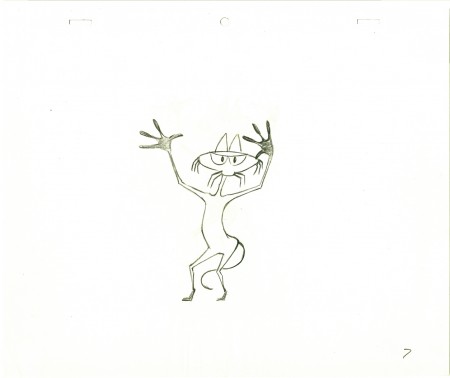
This is an animation drawing I have of one of them.
It’s not as angular or graceful as Corny’s drawing, but I still like it.
.

And this is an animation drawing I have of
Meowrice, the film’s villain.
.
I have lots of the press material from the period stuffed into a scrapbook I have in storage. Not much of this is available on line, but I did find these two pieces in the NYTimes:
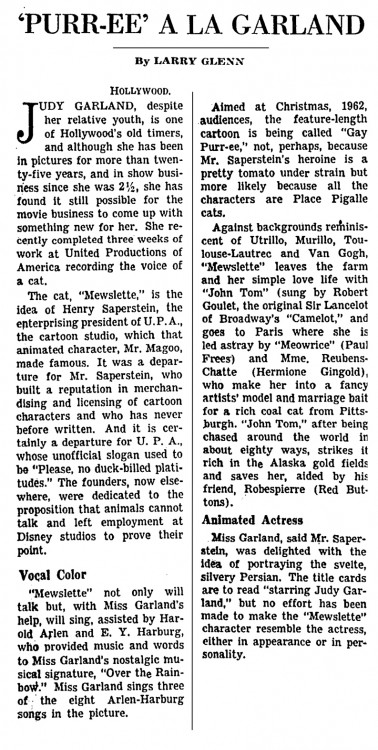
(Click any image to enlarge.)
Here’s the review that was published in the NYTIMES
- GAY PURR-EE
By BOSLEY CROWTHER
December 6, 1962
MOVING (for the second time) into the animated feature domain created by Walt Disney, U.P.A. Productions has contributed a pretty, pleasant, seasonal package for family audiences called “Gay Purr-ee.” The contents of this Warner release, which opened yesterday in neighborhood theaters, should make anybody’s mouth water, including Mr. Disney’s.
Consider: Judy Garland, no less, and Robert Goulet providing the singing and speaking voice tracks for the leading cartoon roles in a cute fable about a little country cat who goes to Paris. Add a battery of technical wizards who create a fetching color canvas that blends some truly lovely pastels with classical works by art masters. Add also eight new tunes by Harold Arlen, including one knockout. But the picture, hélas, is not.
At the risk of sounding like Scrooge, one U.P.A. fan feels that the film has everything but real wit. And what an opportunity, especially with Mewsette, the dainty little fugitive from Provence (Miss Garland), naïvely involved with some purring city slickers before being rescued by hel stalwart country swain, a champion mouser named Juane-Tom (Mr. Goulet).
Now, with all due respect to the film’s good-natured tone and diverting backgrounds, the first half is rather studied and even familiar, as directed by Abe Levitow and written by Dorothy and Chuck Jones. In contrast to the pictorial wizardry—rearranged Von Gogh landscapes and a tilted, spangled City of Light flavored with Toulouse-Lautrec, Modigliani, Matisse, Cézanne and others—the characters almost pale by contrast.
Mewsette, a nice enough little lady cat, is most interesting when Miss Garland is warbling — superbly — such ballads as “Roses Red” and “Take My Hand, Paree.” The same goes for the villainous Meowrice (Paul Frees), a fairly standard menace with a fine, jazzy theme song, “The Money Cat.” Furthermore, the snug, simple plot is needlessly stretched. Even with little Mewsette pining away in Paris, her would-be rescuer and his sassy, furry sidekick Robespierre (Red Buttons) are way off in Alaska.
The nearest thing to spice is the heroine’s jowly, pink “chaperone,” a shady lady named Mme. Rubens-Chatte (drolly spoken by Hermione Gingold). Even with the songs and the brilliantly stylized backgrounds, one can’t help wondering what a Disney crew would have concocted in earthy slyness and spontaneity.
In the final reel, though, things hit high gear in an old-fashioned chase scramble, against a superbly imaginative panorama of Paris, while the cats prowl the quays and the Notre Dame gargoyles toward a final, funny free-for-all. This portion also contains the film’s visual highlight, as Miss Garland sings one of Mr. Arlen’s great blues numbers written for the screen, “Paris Is a Lonely Town.”
So who needs eggnog for Christmas? “Gay Purr-ee” is a nice, soft drink for all the family.
‘Gay Purr-ee’ Cartoon , screenplay by Dorothy and Chuck Jones; directed by Abe Levitow; produced by Henry G. Saperstein for U. P. A. Productions; presented by Warner Brothers.
At neighborhood theaters. Running time: 86 minutes.
Voice of:
Mewsette . . . . . . . . . . . Judy Garland
Juane-Tom . . . . . . . . . . Robert Goulet
Meowrice . . . . . . . . . . . Paul Frees
Robespierre . . . . . . . . . Red Buttons
Mme. Ruben-Chatte . . . . Hermione Gingold

 1
1
 2
2
 3
3
 4
4
 5
5
 6
6 7
7 8
8 9
9 10
10
 11
11
 12
12
 13
13 14
14
 15
15
 16
16 17
17

